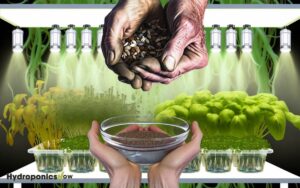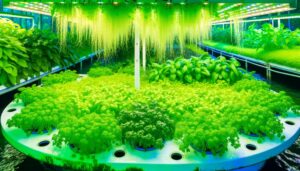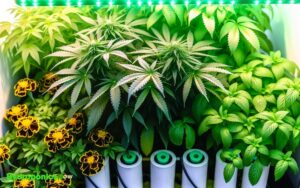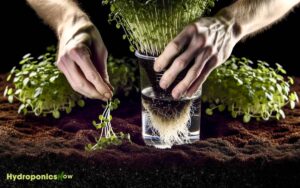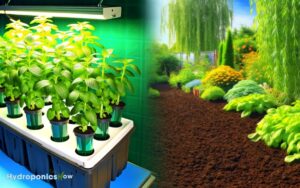Discover 3 Edible Plants Grown Hydroponically
You can grow a diverse range of edible plants hydroponically.
- Leafy greens like lettuce, spinach, and kale thrive with rapid growth cycles, maturing in 30-60 days.
- Herbs such as basil, cilantro, and mint flourish, ready for harvest in 4-6 weeks.
- Tomatoes and peppers need a balanced nutrient mix and controlled environments.
Strawberries and beans show increased yields in systems like NFT or DWC, while radishes and microgreens are quick to mature, with radishes ready in 25-30 days.
Microgreens offer nutrient density, harvesting in just 7-14 days. Each plant requires specific conditions optimal nutrient solutions, temperature, and pH levels for peak growth. Discover more intricacies of hydroponic cultivation techniques and plant-specific needs.

Key Takeaways
Leafy Greens
Leafy greens, such as lettuce, spinach, and kale, thrive in hydroponic systems due to their rapid growth rates and minimal nutrient requirements.
You’ll find that lettuce varieties like Romaine and Butterhead can reach harvest maturity in just 30-35 days. Spinach, another excellent choice, requires around 40-45 days to mature. Kale, known for its dense nutritional profile, typically takes 50-60 days.
These plants demand a nutrient solution with an ideal electrical conductivity (EC) of 1.2-1.8 mS/cm and a pH range of 5.5-6.5. Excellent light conditions involve 12-16 hours of fluorescent or LED light daily.
Herbs
Herbs like basil, cilantro, and mint flourish in hydroponic systems due to their fast growth cycles and relatively low nutrient demands. You’ll find that these herbs can mature rapidly, often within 4-6 weeks, providing you with a continuous supply.
Here’s why hydroponics suits them well:
- Water Efficiency: Hydroponics uses up to 90% less water than traditional soil gardening, beneficial for water-intensive herbs like mint.
- Controlled Nutrient Delivery: Nutrient solutions can be fine-tuned to meet specific plant needs, ensuring ideal growth.
- Space Utilization: Vertical farming techniques allow you to grow more herbs in less space, perfect for urban settings.
Tomatoes
When growing tomatoes hydroponically, you’ll need to guarantee a balanced nutrient solution with a nitrogen-phosphorus-potassium ratio of 10-5-20 for peak growth.
Maintain a temperature range of 65-75°F and a relative humidity of 60-70% to replicate their ideal conditions.
Regular monitoring for pests like spider mites and aphids is essential, as these can greatly impact yield.
Nutrient Requirements
Tomatoes in hydroponic systems require a meticulously balanced nutrient solution, rich in nitrogen, phosphorus, potassium, and trace elements to guarantee ideal growth and fruit production.
You’ll need to confirm the nutrient solution has the correct pH, typically between 5.5 and 6.5, to facilitate peak nutrient uptake.
Monitor the electrical conductivity (EC) to maintain the right nutrient concentration.
Here’s what you should focus on:
- Nitrogen (N): Essential for vegetative growth; maintain a concentration of 150-200 ppm.
- Phosphorus (P): Vital for root development and energy transfer; keep it at 50-70 ppm.
- Potassium (K): Key for fruit quality and disease resistance; target 200-300 ppm.
Regularly test and adjust to meet these parameters for best outcomes.
Ideal Growing Conditions
To maximize tomato yields in hydroponic systems, guarantee ideal growing conditions by maintaining a temperature range of 70-75°F during the day and 60-65°F at night. Consistency in temperature is essential for ideal photosynthesis and fruit development.
Maintain relative humidity between 60-70% to prevent fungal diseases while promoting transpiration.
Utilize high-intensity LED grow lights, providing 14-18 hours of light daily, ensuring an adequate Photosynthetically Active Radiation (PAR) range of 400-700 nm.
Monitor electrical conductivity (EC) levels, keeping them between 2.0-3.5 mS/cm to optimize nutrient uptake. pH levels should be consistently monitored and maintained between 5.5-6.5 for nutrient availability.
Implementing these data-driven practices will greatly enhance your hydroponic tomato cultivation.
Common Pests Control
Effectively controlling common pests in hydroponic tomato systems involves identifying and targeting specific insects such as aphids, whiteflies, and spider mites through integrated pest management strategies. You’ll need to monitor regularly and adopt precise measures.
- Biological Control: Introduce natural predators like ladybugs and parasitic wasps which feed on aphids and whiteflies, reducing their population.
- Chemical Control: Apply neem oil or insecticidal soaps, which are effective against a broad spectrum of pests and safe for hydroponic systems.
- Mechanical Control: Utilize sticky traps and mesh screens to physically capture and prevent pests from accessing your tomato plants.
Peppers
When growing peppers hydroponically, you’ll need to maintain temperatures between 70-80°F and maintain a pH level of 6.0-6.5 for peak growth.
Peppers require a balanced nutrient mix with increased levels of potassium and phosphorus during fruiting stages.
Common varieties like Bell, Jalapeño, and Habanero adapt well to hydroponic systems, providing high yields and vibrant colors.
Optimal Growing Conditions
Peppers thrive in hydroponic systems when the nutrient solution maintains a pH level between 5.5 and 6.5, ensuring peak nutrient absorption.
To achieve ideal growth conditions, focus on three critical factors:
- Temperature: Maintain an environment between 70°F and 85°F during the day, and 60°F to 70°F at night. This temperature range promotes excellent metabolic activity and growth rates.
- Light: Provide 14-16 hours of high-intensity light daily. Use LED grow lights with a spectrum tailored for vegetative growth and flowering stages.
- Humidity: Keep relative humidity between 60% and 70%. This range minimizes transpiration stress and supports healthy leaf development.
Nutrient Requirements
Ensuring ideal growth, peppers in hydroponic systems require a balanced nutrient solution rich in nitrogen, phosphorus, potassium, calcium, magnesium, and trace elements.
Nitrogen supports vigorous leaf and stem growth, while phosphorus is essential for root development and flowering. Potassium ensures strong overall plant health and enhances resistance to diseases.
Calcium is vital for cell wall formation, preventing issues like blossom-end rot. Magnesium acts as a central atom in chlorophyll, aiding photosynthesis, and trace elements like iron, manganese, and zinc support various enzymatic functions.
Aim for an electrical conductivity (EC) of 2.0-3.0 mS/cm and a pH of 5.5-6.5 to optimize nutrient uptake. Regularly monitor and adjust nutrient levels to maintain these parameters for ideal pepper growth.
Common Varieties
Among the numerous varieties of peppers suitable for hydroponic growth, bell peppers (Capsicum annuum), hot peppers (Capsicum frutescens), and sweet peppers (Capsicum chinense) stand out due to their distinct growth habits, nutrient requirements, and yield potentials.
You’ll find that each type demands specific attention:
- Bell Peppers (Capsicum annuum): Require moderate nutrient solutions and stable pH levels. They’re ideal for beginners.
- Hot Peppers (Capsicum frutescens): Thrive in slightly higher temperatures and require increased potassium levels for best fruiting.
- Sweet Peppers (Capsicum chinense): Need consistent humidity control and a balanced nutrient mix for maximum sweetness.
Strawberries
Harnessing the advantages of hydroponic systems, strawberries can achieve peak growth rates and higher yields compared to traditional soil cultivation.
By optimizing nutrient delivery and maintaining precise environmental controls, you can cultivate strawberries with greater efficiency.
Studies reveal that hydroponically grown strawberries exhibit up to 30% faster growth cycles and a 25% increase in yield. Utilizing techniques like the Nutrient Film Technique (NFT) or Deep Water Culture (DWC), you can guarantee consistent nutrient uptake and oxygenation.
Additionally, hydroponics reduces the risk of pathogens and pests, providing cleaner and safer produce. Monitoring pH levels (5.5-6.5) and maintaining nutrient solutions with exact micro and macronutrient profiles are essential for maximizing strawberry health and productivity.
Cucumbers
Similar to strawberries, cucumbers thrive in hydroponic systems where controlled environments and precise nutrient delivery can lead to greatly enhanced growth rates and yields.
You’ll need to focus on three critical aspects:
- Nutrient Solution: Maintain a balanced solution with an Electrical Conductivity (EC) of 2.2-2.7 mS/cm and a pH level of 5.5-6.0.
- Temperature and Humidity: Keep daytime temperatures at 75-80°F (24-27°C) and nighttime temperatures around 65°F (18°C). Humidity levels should be 70-80%.
- Light: Provide 14-18 hours of light per day with an intensity of 400-500 µmol/m²/s.
Beans
Beans are well-suited for hydroponic growth due to their ability to efficiently utilize nutrient solutions and their relatively low-maintenance requirements.
You’ll find that beans, such as bush beans and pole beans, thrive in hydroponic systems like NFT (Nutrient Film Technique) and DWC (Deep Water Culture).
They require a pH range of 6.0 to 6.5 and an EC (Electrical Conductivity) of 1.8 to 2.3 mS/cm.
Make sure your nutrient solution is rich in nitrogen, potassium, and phosphorus to support vigorous vegetative growth and pod formation.
Maintain a temperature range of 65-75°F (18-24°C) for best growth.
Beans’ rapid growth cycle, typically 50-70 days, allows for multiple harvests annually, making them a productive choice for hydroponic cultivation.
Radishes
Radishes are an excellent choice for hydroponic systems due to their rapid growth cycle, typically maturing in just 25-30 days. You’ll appreciate their nutrient-dense profile, rich in Vitamin C and potassium.
To maximize growth, maintain a nutrient solution with a pH level of 6.0-7.0 and an Electrical Conductivity (EC) of 1.6-2.2 mS/cm.
Here’s a simple guide:
- Germination: Start seeds in rock wool or peat pellets for best moisture retention.
- Light: Provide 12-14 hours of fluorescent light daily to enhance photosynthesis.
- Watering: Guarantee a consistent flow of oxygenated water to prevent root rot.
Microgreens
Microgreens, known for their high nutrient density and rapid growth, are another excellent choice for hydroponic systems, often ready for harvest in just 7-14 days.
You’ll find that these young plants, typically harvested at the cotyledon stage, offer concentrated vitamins and minerals. Varieties like radish, broccoli, and arugula are popular due to their robust flavor profiles and nutritional benefits.
In hydroponics, you can utilize a nutrient-rich water solution, ensuring ideal growth conditions. Studies show microgreens can contain up to 40 times higher nutrient levels than their mature counterparts. This makes them an excellent choice for health-conscious individuals looking to maximize their nutrient intake. Additionally, cultivating hydroponic plants for betta fish can create a sustainable system where plants help filter the water while providing a natural environment for the fish. By integrating hydroponics with aquaponics, you can efficiently grow fresh, nutrient-dense plants while maintaining a healthy aquatic habitat.
Maintain consistent light exposure, around 12-16 hours daily, and keep a temperature range of 18-22°C (64-72°F) for best results. This approach maximizes yield and nutrient retention.
Conclusion
You’ve now got the knowledge to grow an Eden of edible plants hydroponically.
Imagine your leafy greens thriving like Jack’s beanstalk, your herbs as lush as Shakespeare’s gardens, and your strawberries as sweet as forbidden fruit.
Hydroponics offers a data-driven, efficient approach to cultivating tomatoes, peppers, cucumbers, beans, radishes, and microgreens.
With precision, your indoor garden could rival nature’s own.
So, why wait? Start your hydroponic journey and let your plants flourish like never before.

